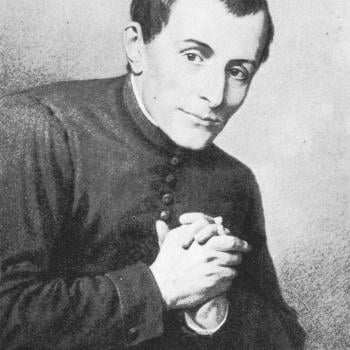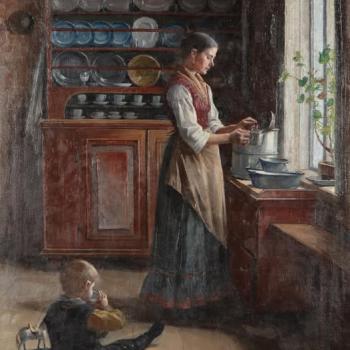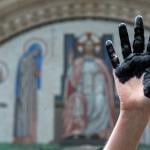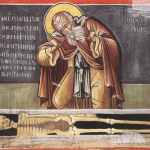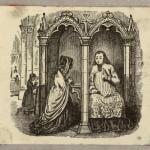One of the most interesting things that we as human beings do is to weep. From a purely scientific perspective tears are a lubricating fluid that pours across the cornea. They are created when the lacrimal gland is stimulated by the neurotransmitter acetylcholine through the nicotinic and muscarinic receptors.[1] Although this tells us a bit about the physicality of tears it doesn’t tell us much about why we cry, and how it impacts us spiritually. Tears are a unique specimen of human behavior. Tears connect us with a part of ourselves and an expression of our deepest feelings that is far beyond our words or even our thoughts. Tears are a way that our bodies express our hearts. In Christian history there were few people as concerned with the activity of the heart, and with the accompanying tears, as the desert fathers. These were people who lived in the third and fourth century. In an effort to find healing and live a life of submission to the kingdom of God, these men and women lived lives of penitent tears in the deserts of the ancient Roman Empire.
Lives of Penance
Penance at this time in the history of Church was quite a bit different than the life of penance that we find among the Roman Catholic Church today. At this time penance was done as a response to grave sins (like murder or adultery) that were done after a Christian was baptized.[2] Penance was a way that a Christian who had committed a grave sin could be restored to the community. It was an act of contrition done by an individual in cooperation with the standards set out by the church, an act of both personal and corporate piety.
Penance in the early centuries of the Church was considerably harsher and longer (lasting years) than its contemporary corespondent. It involved a change of attire, a regimen of strict fasting, prayer, and alms giving. These were all things that the Desert fathers also did; they wore distinctive attire, fasted extensively, and in many cases gave away everything that they owned.
On top of these basic lifestyle changes the penitent Christian often had to move through four stages of life within the Christian community. These four stages helped point the heart of the sinner back to a submission to God, and the healing grace of Christ. The stages can be summarized as follows:
- The Mourner – At this stage the penitent Christian was not even allowed back into the church building. They would sit outside as the liturgy was being prayed, begging their fellow believers to pray for them
- The Hearer – At this stage the penitent Christian was allowed back in the church, but was not allowed to stay for the celebration of the Eucharist. After the reading of scripture and homily were completed the penitent Christian had to leave.
- The Faller – At this stage the penitent Christian would be permitted to remain in the church for the whole service, but would be required to lay prostrate on the floor during the sacred rite.
- The Stander – In this final stage the penitent Christian would be allowed to stand during the Eucharist, but would not be able to partake in it.
After all of these stages had been passed a monk was allowed again to join in the blessed sacrament.[3]
Desert Christians viewed their whole lives as an act of Penance. Sometimes they did this because they had actually done some great wrong. For example, there was one monk named Abba Apollos who took up the monastic life after becoming consumed with guilt when he murdered a pregnant women just to see how a child looked within her. After seeing the child he was convicted of his horrendous crime and become a monk the remaining years of his life.[4] There were other monks however who’s penance was not a response to any grave sin, but simply came from a conviction that they must live life in a state of humility. They lived their lives in a similar way to the mourners who were going though the steps toward reconciliation. Although they did not refrain from joining in the table of the Eucharist, they did seek to live every moment in sorrow over their sins. They sought to spend their lives with a tearful heart.
Tears of Penthos
Living lives of sorrow and compunction is often called “penthos” in the desert literature.[5] Penthos was not about being sad or depressed, but a Godly sorrow that took its foundation in the Gospels. It is defined by Richard Foster as · “a broken and contrite heart… inward godly sorrow… blessed, holy mourning… being cut to the heart over our distance and offense to the goodness of God… [and a] Prayer of Tears.” This attitude can be seen all over the sayings of the fathers. On one occasion Abba Poeman was asked what do do about his sins. Poeman responded, “he who wants to pay the ransom for sins, pays for them with tears… Weeping is the path the Scriptures and the Fathers handed down to us. They say ‘weep!’ truly there is no other path than this one ”.[6]
Another father is recorded to have said, “the Lord will not reproach us for not having worked miracles, nor for not having understood the mysteries [of the sacraments], nor for not having possessed the eloquence of the ancients nor theology. But he will judge us for not having lived with tears and lamentations all the days of our lives because of our sins-yes, for this he will reproach us.”[7] This attitude may seem extreme, but it was by no means uncommon among the fathers of the desert. A similar attitude is seen in a saying of Macarius who, when asked by a monk for a “word” by which he might be saved told him, “Sit in your cell and weep for your sins.”[8] It’s not often that those in the Protestant church today look at their tears as a way to salvation, but that is how powerful the desert father saw their tears.
Although the practice of tears may seem odd to many in the church today, the reason the fathers had such a strong emphases on tears was because they took the teaching of Jesus very seriously, and Christ declared “blessed are those who morn”.[9] Interestingly the concept of penthos was so integral to the identity of these early monastics that the Syriac word for penthos and the Syriac word for monk were the same. Both were called ‘abila[10].
What the Tears Were Not Like
Because we live in a culture that is so different than that of the Desert Fathers it is easy to misunderstand what they meant when they talked about weeping and tears. We can easily import a host of meaning that was never intended to be brought in. Because of this I think it is important to clarify a few things that the desert father did NOT mean when they talked about this practice of penthos.
- The Fathers did not mean you should be gloomy or depressed. This sort of attitude is actually considered deadly by the fathers, and goes by the name lupe. Gloom and depression are seen by the fathers as pointing to a sorrow over what was given up by becoming monks, rather than a hope for the holiness they seek to gain.
- This sorrow was also not about focusing on individual sins. Having an attitude of sorrow was supposed to be a way of life, not just a response to wrongs done in the past. Keeping a catalog of sins could actually act as a distraction to fighting the fight in the present moment. Repent and move on, but keep on repenting.
- The tears of penthos were not just tears with prayer, but had to be tears of repentance and sorrow for one’s OWN sin. St. Augustine writes of people who would come to church with a bad practice of tears saying, “They bend their knees, touch the earth with their foreheads, sometimes moistening their faces with tears. And in all this great humility and anguish, they pray: ‘Lord, avenge me. Kill my enemy.’”[11] This was not the sort of tears that the desert fathers looked on as virtuous.
What the Tears Were Like
I don’t want to spend too much time focusing on what this practice was not like, but rather would like to see what ways the fathers viewed their lives of tears as being like. In the literature of the desert fathers there are a few examples that are pointed to that help us get a better grip on what the tears of the fathers were similar to.
- One example used to parallel the life a monk should aim for was given by Abba Poeman. After he saw a women weeping in a cemetery over her husband, son, and brother, who had all died, he told Abba Anoub that the monks life should be like this. Just as that women’s “whole life and spirit [were] sorrow” so too the Monk’s should be.[12]
- Another example of what this life should be like is seen in the person of Mary, the mother of Jesus. Abba Poeman looked to the Mother of Jesus as an example in her sorrow. He wished he too could weep at the foot of the cross.[13] In the deep love in sorrow of Mary, the fathers of the desert found inspiration.
- A third example of what this is like is solidarity with sinners. One story tells of a time when Abba Besarion joined a brother who was refused communion and put out in the place of the mourners saying, “I also am a sinner.”[14]
- Fourth the desert fathers lived with a keen awareness of the eschaton. They believed that the kingdom of God was coming and that they needed to be prepared for it. This attitude is reflected in the sayings of Abba Ammonas. He said that the mindset of a monk should be like that of a criminal who are in prison, saying, “They ask where the judge is, and when he’s going to come, and, while waiting for him, weep. The monk should be that way: always attentive and reproaching his soul, saying: ‘How unhappy I am! How will I ever stand before the judgment seat of Christ the judge? And what will I have to say in my defense?’ If you meditate so all the time, you can be saved.”[15]
The Power of Tears
We have talked a great deal about how the Desert Fathers saw their tears, and also a bit about how the fathers did not see their tears. We have not talked about why they believed their tears were so important. What is it about tears that can save us? What is it about tears, that the fathers believed they would be that by which we were judged on the last day?
To understand what the Fathers meant when they said that the tears could save, it is important to understand the perspective of the Fathers on salvation, because it is different than many peoples understanding of salvation today. To do this we need to begin by making a distinction between forgiveness and salvation. In protestant theology these two things are often conflated into one instance; a person is said to have been saved when they repent of their sins and are forgiven. The Desert fathers did not have this perspective. Do you remember the story of the man who spent the last half of his life as a monk after killing a pregnant women? Well that monk spent many years in sorrow after his deed, and could never be free from the sorrow and grief he felt from the death of the baby in the women’s womb. Late in life he was told by another monk, “God has forgiven you even the death of the child, but he leaves you in grief because that is good for your soul.” Tears of repentance our not meant to convince God that we are worthy of forgiveness, but are meant to assist in healing the sinner and bring their life into submission to the kingdom of God.
The Desert fathers saw salvation as a more holistic sense of healing. Forgiveness is part of being saved, but there is a great deal more to it than that. The desert fathers read through the bible and discovered the language of salvation and the language of healing are interwoven.[16] As we are healed we are saved. This understanding of salvation as healing is actually so important in contemporary Orthodox theology, it has come under fire by some as taking over the whole conversation of salvation.[17] In the mind of the Desert Fathers healing begins in the heart, and tears are a powerful balm. The attitude of the desert fathers is summed up well in the words of Gregory of Nyssa who states, “tears are like blood in the wounds of the soul.”
Because tears deal with a person’s heart they are a powerful tool in the healing of a person from the inside out. Saint Anthony believed the best posture that a person could have was to place guilt for sins upon himself and himself alone before God. Tears of repentance and compunction engage the heart, the mind, and the body before God in humility. From that posture God could use and form a person. Because of this tears were something that were sought after by the fathers, and many of them achieved them as a condition of life. It is said that Abba Arsenius wept so much that he actually hollowed out a cavity in his chest from all of his tears.
One prayer written at this time connects tears to the miraculous water that comes from the rock in the time of the Exodus. It states, “O Lord God, Who pours out mercy and kindness, Who always invites me, the one who always turns away from Thee and yet is benefited by Thee, send compunction upon me, the wretched one; and, as Thou didst in the past with the rock in the desert, make my stony and petrified heart gush forth fountains of tears.”[18] Tears are a source of life to those who are hard of heart, and lifeless.
Tears For All
Those who weep find themselves in good company. Not only are tears an important part of the spirituality of the desert fathers, they are also an important part of the lives of many in the scriptures. Indeed the fathers were inspired by the scriptures to live out their life of tears. In Job we read the righteous Job cry out, “My eye weeps to God.”[19] The prophet Isaiah “drenches” those he prays for with tears.[20] Jeremiah says that he prays day and night, and compared his eyes to a fountain of tears.[21] In the book of Lamentations, the author calls the people in Jerusalem to cry so much that their tears form a torrent day and night.[22] The book of Psalms also point to tears as a witness to God.[23] Finally and most importantly Jesus Christ himself is described as one who wept.[24] Crying is not only reserved for strange Ascetics, but makes up the spiritual life of people of faith in Scripture and throughout history.
The fathers and mothers in the desert found healing and life in the kingdom of God through lives of penitent tears. Today we do not need to flee to Egyptian deserts to find this same life. We too can sit at the feet of three cross; we too can live our lives in light of the judgment; we too join with those who are cast out; and we can embrace a way of life that reflects the promise of Jesus Christ that those who morn are indeed blessed.
NOTES
[1]Snell, Richard S., and Michael A. Lemp. Clinical Anatomy of the Eye. 2nd ed. (Malden, MA, USA: Blackwell Science, 1998),122.
[2]Loughlin, Frank. The Future of the Sacrament of Penance . (Mahwah, N.J.: Paulist Press, 2009), 23.
[3]Watkins, Oscar D.. A History of Penance; Being a Study of the Authorities, Volume 2.. (New York: B. Franklin, 1961), 241.
[4]Harmless, William. Desert Christians: An Introduction to the Literature of Early Monasticism. (Oxford: Oxford University Press, 2004), 239.
[5]Foster, Richard J.. Prayer: Finding the Heart’s True Home. (San Francisco: HarperSanFrancisco, 1992), 37.
[6]Harmless, 239
[7]Harmless, 240.
[8]Shenouda III, Pope , H.G. Suriel, tr. Tears in the Spiritual Life. (Syndey: Coptic Orthodox Publishing and Translating, 1997), 50.
[9]Matthew 5:4
[10]Harmless, 239.
[11]Harmless, 236.
[12]Chryssavgis, John. In the Heart of the Desert: the Spirituality of the Desert Fathers and Mothers : with a translation of Abba Zosimas’ Reflections. (Bloomington, Ind.: World Wisdom, 2003), 90.
[13]Merton, Thomas, and Patrick F. Connell. Cassian and the Fathers: initiation into the monastic tradition. (Kalamazoo, Mich.: Cistercian Publications, 2005), 80.
[14]Hannay, James. Wisdom of the desert . (S.l.: Revelation Insight, 2008), 51.
[15]Harmless, 240.
[16]Allen, Joseph J., and Philip Saliba. Orthodox Synthesis: The Unity of Theological Thought : An Anthology Published in Commemoration of the Fifteenth Anniversary of Metropolitan Philip as Primate of the Antiochian Orthodox Christian Archdiocese of North America. (Crestwood, N.Y.: St. Vladimir’s Seminary Press, 1981), 215.
[17]Horton, Michael . “Maybe: An Orthodox Perspective: Responses.” In Three Views on Eastern Orthodoxy and Evangelicalism by James J. Stamoolis, and Bradley Nassif. (Grand Rapids, Mich.: Zondervan, 2004), 261.
[18]Patton, Kimberley C., and John Stratton Hawley. Holy Tears: Weeping in the Religious Imagination. (Princeton, NJ: Princeton University Press, 2005), 258-259.
[19]Job 16:20
[20]Isaiah 16:9
[21]Jerimiah 9:1
[22]Lamentations 2:18
[23]Psalm 56:8; 42:3; 119:136
[24]Hebrews 5:7 and John 11:35






